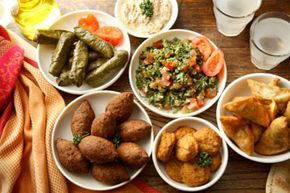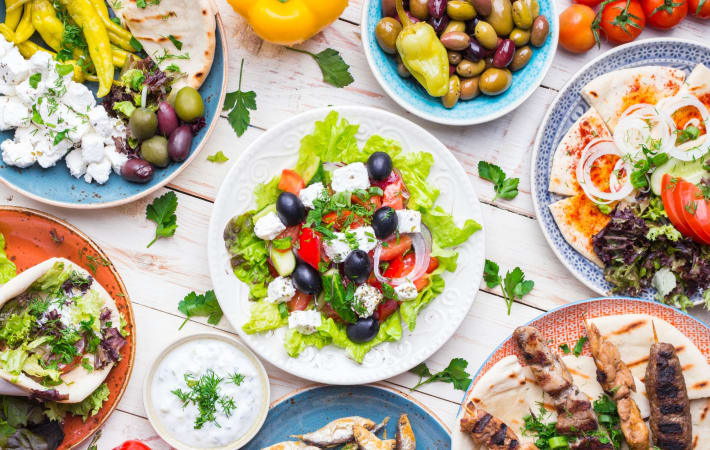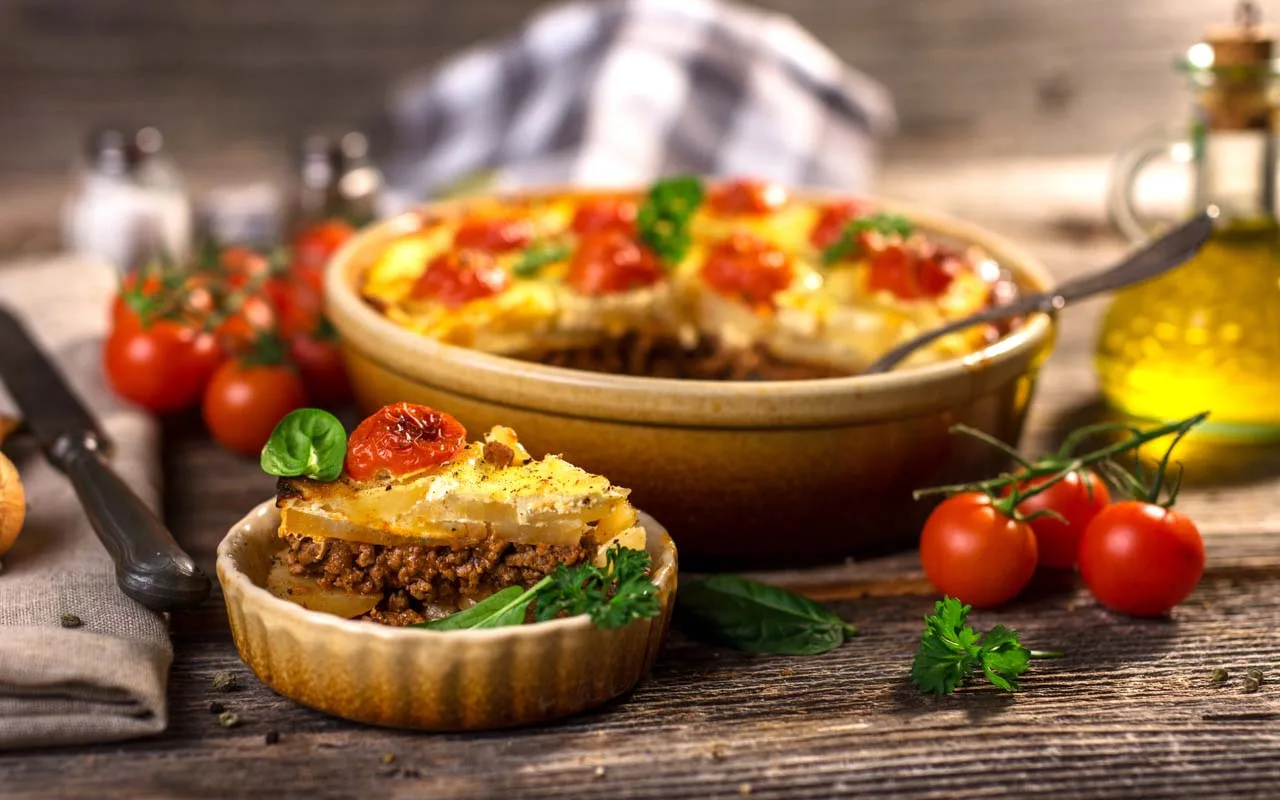Greek food culture is rich and diverse. It offers a blend of flavors that excite the senses.
Greek cuisine is more than just food; it’s a way of life. With a history that spans centuries, Greek food reflects the country’s traditions and landscapes. Fresh ingredients like olive oil, herbs, and vegetables are staples in Greek dishes. Meals are often shared with family and friends, making dining a social event.
Whether you are enjoying a simple salad or a lavish feast, Greek food brings people together. This introduction will dive into the heart of Greek food culture, exploring its roots and the unique elements that make it beloved worldwide. Let’s embark on a flavorful journey through Greece!

Introduction To Greek Food Culture
Greek food culture is a celebration of flavors, history, and tradition. It’s a way of life that brings people together around the table. Greek cuisine is known for its fresh ingredients, vibrant colors, and bold flavors. From hearty stews to light salads, Greek food offers something for everyone. Let’s explore the elements that make Greek food culture unique.
Historical Influence
Greek cuisine has been shaped by its rich history and diverse influences. Ancient Greece laid the foundation with simple, wholesome ingredients. Olive oil, grains, and wine were staples. The Byzantine era introduced new spices and techniques. Later, the Ottoman rule brought flavors from the East. Each period added layers of complexity to Greek dishes.
Today, Greek food reflects this blend of historical influences. You’ll find traces of Italian, Balkan, and Middle Eastern flavors. Yet, it remains distinctly Greek. The use of fresh, local ingredients is a constant. Seasonal produce, herbs, and seafood play crucial roles. Traditional cooking methods are still cherished. They connect modern Greeks to their past.
Mediterranean Diet Basics
The Mediterranean diet is at the heart of Greek food culture. It’s known for its health benefits and delicious simplicity. This diet emphasizes plant-based foods and healthy fats. Olive oil is a key component, used in almost every dish. Whole grains, fruits, and vegetables are abundant.
Here’s a quick overview of the Mediterranean diet:
- Fruits and Vegetables: Fresh, seasonal produce is vital.
- Whole Grains: Bread, pasta, and cereals are usually whole grain.
- Olive Oil: The primary source of fat, rich in antioxidants.
- Seafood: Fish and shellfish are common, providing omega-3 fatty acids.
- Legumes: Beans and lentils are important protein sources.
- Dairy: Cheese and yogurt are consumed in moderation.
- Herbs and Spices: Used to flavor dishes without excess salt.
Meals are often accompanied by wine, enjoyed in moderation. Social gatherings are a big part of Greek dining. Sharing food with family and friends is a cherished tradition. This communal aspect adds to the diet’s overall benefits.
The Mediterranean diet is more than just food. It’s a lifestyle. It promotes balance, variety, and enjoyment. It’s no wonder that Greek cuisine is loved worldwide.
Staple Ingredients In Greek Cuisine
Greek cuisine is known for its rich flavors and fresh ingredients. The Mediterranean diet, often celebrated for its health benefits, has many of its roots in Greek food culture. Let’s explore the staple ingredients that make Greek dishes so unique and delicious.
Olive Oil And Olives
Olive oil is the cornerstone of Greek cuisine. It is used in almost every dish. From salads to cooked meals, this liquid gold adds a unique flavor. Greeks use extra virgin olive oil for its pure taste. Olives themselves are also a key ingredient. They are eaten as snacks, added to dishes, or used to make olive paste. The variety of olives in Greece is impressive. Each type has its own distinct taste and texture.
Feta Cheese And Dairy
Feta cheese is another essential ingredient in Greek cooking. Made from sheep’s milk or a mix of sheep and goat milk, it has a tangy flavor. Feta is crumbled over salads, baked in pies, or served with bread. Dairy products in Greece go beyond just feta. Greek yogurt is thick, creamy, and often enjoyed with honey or fruit. It is also used in many savory dishes. Dairy plays a big role in Greek desserts too. You will find it in custards, cakes, and pastries.
Traditional Greek Dishes
Greek food culture is rich and diverse, offering a variety of traditional dishes. These dishes are known for their bold flavors and fresh ingredients. Each recipe tells a story and brings a taste of Greek history to your plate.
Moussaka And Pastitsio
Moussaka is a classic Greek dish. It is made with layers of eggplant, ground meat, and béchamel sauce. The dish is baked until golden and bubbly. Each bite is a perfect blend of savory flavors.
Pastitsio is another beloved Greek dish. It is similar to lasagna but with a unique twist. The dish includes pasta, ground beef, and a creamy béchamel sauce. The top layer is baked to a perfect golden crust. Both dishes are comfort food at its finest.
Souvlaki And Gyros
Souvlaki is a popular street food in Greece. It consists of skewered and grilled meat, often served with pita bread. The meat can be chicken, pork, or lamb. It is usually marinated in a mixture of olive oil, lemon juice, and herbs.
Gyros are another favorite. They are similar to souvlaki but the meat is cooked on a vertical rotisserie. The meat is thinly sliced and served in pita bread. It comes with tomatoes, onions, and tzatziki sauce. Both dishes are delicious and offer a taste of Greek street food culture.

Greek Meze Culture
Greek food culture is rich and diverse, with deep-rooted traditions. One of the highlights is the Greek meze culture. Meze refers to a variety of small dishes served as appetizers. It is not just about the food, but the experience of sharing and socializing. Meze dishes are meant to be enjoyed slowly, with good company and conversation.
Popular Meze Dishes
Greek meze includes a wide array of flavors and textures. Tzatziki is a favorite, made from yogurt, cucumber, and garlic. Saganaki is fried cheese, crispy on the outside and melty inside. Dolmades are grape leaves stuffed with rice and herbs. Spanakopita is a spinach and feta cheese pie, wrapped in flaky pastry. Calamari is lightly battered and fried squid, often served with lemon.
Social Aspects Of Meze
Meze is more than just food; it’s a social event. Greeks gather around the table, sharing stories and laughter. Each dish is passed around, creating a communal experience. Meze encourages a slow pace, allowing time for conversation. It’s common to enjoy meze with a glass of ouzo or local wine. This shared dining experience strengthens bonds and creates lasting memories.
Greek Desserts And Sweets
Greek desserts and sweets offer a delightful journey for the taste buds. These treats often feature rich flavors, simple ingredients, and a touch of tradition. From nutty pastries to creamy delights, Greek desserts are a must-try for any food lover.
Baklava And Galaktoboureko
Baklava is perhaps the most famous Greek dessert. It consists of layers of crispy phyllo dough filled with a mix of nuts. The whole thing is sweetened with syrup or honey. The result is a flaky, sweet treat that melts in your mouth.
On the other hand, Galaktoboureko is a custard-filled dessert. It also uses phyllo dough but adds a creamy custard in the middle. Once baked, it is soaked in a sweet syrup. This gives it a rich, moist texture.
Honey And Nut-based Treats
Many Greek desserts feature honey and nuts. These ingredients add natural sweetness and crunch.
- Melomakarona: Honey-soaked cookies often topped with ground nuts.
- Karydopita: A walnut cake soaked in honey syrup.
- Loukoumades: Small honey-drenched doughnuts sprinkled with nuts.
Honey and nuts are staples in Greek sweets. They bring out the flavors and give a satisfying crunch.
Regional Culinary Variations
Greek food culture is rich and diverse, with each region offering its own unique flavors. From the sun-kissed islands to the mountainous north, regional culinary variations make Greek cuisine truly special. Exploring these differences can provide a deeper appreciation of Greece’s food heritage.
Island Specialties
The Greek islands boast fresh seafood, vibrant salads, and aromatic herbs. Santorini is known for its cherry tomatoes and fava beans. Mykonos offers kopanisti, a spicy cheese spread. Crete features dishes like dakos, a rusk salad topped with tomatoes and cheese. Islanders use local ingredients, ensuring fresh and flavorful meals.
Northern Greece Flavors
Northern Greece has hearty and flavorful dishes. Thessaloniki is famous for bougatsa, a custard-filled pastry. The region enjoys meat dishes like spetsofai, a sausage and pepper stew. Freshwater fish from lakes and rivers often appear on menus. Influences from nearby countries add unique spices and flavors.
Seasonal And Festive Foods
Greek food culture is rich and varied, especially during seasonal and festive times. These special periods bring unique dishes that reflect the seasons and traditions. Whether it is Easter, Christmas, harvest, or summer, Greeks have specific foods that make each occasion memorable.
Easter And Christmas Dishes
During Easter, one of the most important Greek holidays, families come together to celebrate with traditional foods. Lamb is a staple, often roasted on a spit, which symbolizes Christ’s sacrifice. Another popular dish is Magiritsa, a hearty soup made from lamb offal and greens.
For Christmas, the focus shifts to different flavors. A favorite dish is Christopsomo, or Christ’s Bread, which is a sweet bread decorated with a cross. Melomakarona are honey-drenched cookies that are a must-have during this season. These sweets are deeply rooted in Greek tradition and are enjoyed by all ages.
Harvest And Summer Foods
During the harvest season, Greeks celebrate with foods that highlight the abundance of the land. Olives, grapes, and figs are harvested and used in various dishes. A common harvest dish is Gemista, which are vegetables like tomatoes and peppers stuffed with rice and herbs.
Summer brings fresh and light foods to the Greek table. Greek Salad, known as Horiatiki, is a popular choice, made with fresh tomatoes, cucumbers, onions, olives, and feta cheese. Another summer favorite is Grilled Octopus, often served with a splash of lemon and olive oil.
| Season | Dish | Main Ingredients |
|---|---|---|
| Easter | Magiritsa | Lamb offal, greens |
| Christmas | Melomakarona | Honey, flour, nuts |
| Harvest | Gemista | Tomatoes, peppers, rice, herbs |
| Summer | Greek Salad | Tomatoes, cucumbers, onions, olives, feta cheese |
Modern Influences On Greek Cuisine
Greek cuisine has a rich history. Yet, modern influences have brought new flavors and techniques. Today, many chefs blend traditional and contemporary styles. This fusion creates exciting and delicious dishes. Here, we explore these modern influences.
Fusion And Contemporary Dishes
Fusion cuisine combines elements from different culinary traditions. In Greece, you see this in many new dishes. For instance, Greek sushi uses fresh seafood with Mediterranean herbs. Another example is moussaka lasagna. This dish mixes classic Greek moussaka with Italian lasagna.
Chefs also experiment with new ingredients. They use quinoa, avocado, and other superfoods. These ingredients add a modern twist to Greek recipes. They make the dishes healthier and more diverse.
Globalization Impact
Globalization has greatly influenced Greek cuisine. Many Greek chefs have trained abroad. They bring back new techniques and ideas. This makes Greek food more diverse and exciting.
Tourism also plays a role. Visitors from around the world come to Greece. They bring their tastes and preferences. Greek restaurants adapt to these new demands. This leads to a mix of global flavors in traditional Greek dishes.
Importing food products has also changed Greek cuisine. Exotic spices, sauces, and vegetables are now available. These ingredients enrich traditional recipes and create new ones.
Examples Of Modern Greek Dishes
| Traditional Dish | Modern Twist |
|---|---|
| Souvlaki | Tofu Souvlaki with Quinoa Salad |
| Spanakopita | Spanakopita Spring Rolls |
| Baklava | Chocolate Baklava |
Greek Food And Health Benefits
Greek food is not only delicious but also packed with health benefits. This Mediterranean cuisine is rich in nutrients and helps maintain a healthy lifestyle. The diet includes a variety of fresh vegetables, fruits, grains, and lean proteins. These foods contribute to overall well-being and longevity.
Nutritional Value
The Greek diet is known for its high nutritional value. It includes plenty of vegetables, fruits, whole grains, and healthy fats. Olive oil, a staple in Greek cuisine, is rich in monounsaturated fats. These fats help reduce bad cholesterol levels.
Here’s a quick look at the nutritional components found in common Greek foods:
| Food Item | Main Nutrients |
|---|---|
| Olive Oil | Healthy fats, vitamin E, antioxidants |
| Feta Cheese | Calcium, protein, vitamin B12 |
| Greek Yogurt | Probiotics, protein, calcium |
| Chickpeas | Fiber, protein, iron |
Longevity And Well-being
Many Greeks enjoy a long, healthy life. The diet plays a big role in this. Traditional Greek foods are fresh and minimally processed. This reduces the intake of harmful additives and preservatives.
The Mediterranean diet, which includes Greek food, has been linked to reduced risk of chronic diseases. These include heart disease, diabetes, and certain cancers. Here are some key benefits:
- High in antioxidants, which fight inflammation.
- Rich in fiber, aiding in digestion and weight management.
- Includes lean proteins, promoting muscle health.
Incorporating Greek food into your diet can lead to improved well-being. Enjoy a variety of dishes for a balanced and nutritious diet.

Frequently Asked Questions
What Is Traditional Greek Food?
Traditional Greek food includes dishes like moussaka, souvlaki, tzatziki, dolmades, and baklava. These dishes feature ingredients like olive oil, fresh vegetables, lamb, and feta cheese. Greek cuisine emphasizes fresh, local produce and simple cooking techniques.
What Are Traditional Greek Eating Habits?
Traditional Greek eating habits include a Mediterranean diet rich in fruits, vegetables, olive oil, fish, and whole grains. Meals are often communal, emphasizing fresh, local ingredients. Greeks enjoy leisurely meals and prioritize family gatherings. They also consume moderate amounts of wine and enjoy desserts in moderation.
Why Is Food So Important To Greeks?
Food is vital to Greeks as it represents their culture, traditions, and social connections. Meals bring families together and celebrate life.
What Is Greece’s National Food?
Greece’s national food is moussaka. This dish features layers of eggplant, minced meat, and béchamel sauce. It’s a traditional Greek comfort food.
Conclusion
Greek food culture offers rich flavors and traditions. Each dish tells a story. Ingredients are fresh and local. Meals are more than food; they are experiences. Family and friends gather, sharing not just food but life. Greek cuisine connects people through centuries.
Trying Greek food means tasting history. Dive into Greek food culture. Enjoy every bite!



